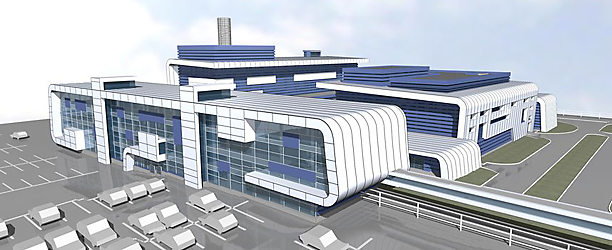The complicated political situation in the world has triggered economic problems in a number of sectors of industry both in Russia and in the western countries. In spite of the sanctions ROSATOM has fulfilled all its obligations towards its foreign partners. Some of them try to use the political game to exercise pressure of the Russian public corporation; however, ROSATOM isn’t afraid of threats.
In fall 2012 construction of a nuclear fuel fabrication plant where fuel is to be made to the Russian technology started in Smolino village (Kirovograd Region, Ukraine). The plant is called for to meet all nuclear fuel needs of the Ukrainian nuclear power plants (they operate VVER reactors of the Russian design). In this project Ukraine’s partner is the Fuel Company of ROSATOM TVEL.
In August some Ukrainian mass media wrote that the FC TVEL allegedly stopped sending equipment for the plant because of aggravation of Russian-Ukrainian relations. The FC TVEL assured that the company had fulfilled fully and in due time all its obligations concerning manufacture of the equipment for the first phase of the nuclear fuel fabrication plant to be built in Ukraine. This equipment is ready for shipment to the Ukrainian partners.
Ready to supply
Today, there are no any technical constraints for the supplies. All necessary stages of the equipment acceptance procedure have been passed; Ukraine’s specialists took part in the acceptance procedure. The equipment manufacture obligations have been fulfilled mainly at the expense of the Russian party so far.
The deal depends on Ukraine. As soon as the Ukrainian shareholder settles the project financing issues and the necessary infrastructure is available for the equipment receipt and storage on the site in Smolino, the equipment will be immediately delivered, the FC TVEL said.
In the recent days the bilateral consultations between the FC TVEL and the State Concern Nuclear Fuel (Ukraine) concerning implementation of the nuclear fuel fabrication project were held in Moscow. Issues thoroughly discussed at the consultations included further financing of the project, approval of the project documentation and construction works on the site. Besides, the licensing agreement and required actions to pay for and deliver the process equipment made by FC TVEL for the first phase of plant were addressed.
Following the meeting results, the parties expressed their readiness for finding out mutually acceptable solutions to the outstanding issues, which would take account of the parties’ interests to the fullest extent. The parties admitted a substantial initial project implementation schedule lag and agreed to update it to specify commissioning dates of the facility’s phase one.
The next bilateral consultation will be held in Ukraine and tied up to the general shareholders’ meeting of the company NF Plant, which is scheduled for September 4, 2014.
There’ll be enough uranium
Australia has threatened to step in the exchange of sanctions between Russia and the West. The Government of this country has stated that is could ban selling uranium to Russia. “I want to say very clearly that we are working towards stronger sanctions,” Prime Minister of Australia Tony Abbott said. “Now that our personnel have withdrawn from the site, now that our personnel are in the process of returning to The Netherlands after largely completing Operation Bring Them Home [on the place of Boeing 777 crash], certainly you will find increased sanctions by Australia,” he said.
The Russian uranium feedstock would be enough to meet the requirements of ROSATOM’s projects in the coming 100 years, Sergey Novikov, the Director of the Communications Department of ROSATOM, said, commenting on the information about a possible ban on uranium feedstock deliveries from Australia.
“Russia is ranked second in uranium resources in the world,” Novikov reminded. “Feedstock of the deposits in Russia and overseas (in particular, in Kazakhstan) will be enough to supply ROSATOM’s projects both in Russia and abroad for the coming 100 years,” he said.
As a confirmation of these words, ROSATOM’s uranium mining company JSC Khiagda has started preparing for uranium mining at two new deposits. These are Istochnoye and Vershinnoye deposits in Bauntovsky Region of the Republic of Buryatia. Specialists estimate resources of these deposits at nearly 7,000 tons.
“We will start from development of Istochnoye deposit as the closest to the main process building and most prepared one. It is one of the best in terms of uranium assay in Khiagdinskoye Field,” Khiagda CEO Alexei Dementiev noted. “In parallel, we are getting ready to develop Vershinnoye deposit, which approved resources are 4,577 tons of uranium. This is a very attractive deposit; its resources are of good quality. Besides, its mineral resources can be greater; so we plan for additional exploration in the midterm at this deposit,” he said.
Explorations and engineering surveys have been completed at Istochnoye deposit. Now, specialists of JSC Khiagda prepare for building roads, electricity transmission lines, line controls, infrastructure facilities and drilling. At Vershinnoye deposit the engineering surveys are under way for the design purposes. Next year, 92 process wells will be drilled there.
At Istochnoye deposit uranium mining will start in 2016 and at Vershinnoye deposit in 2017, The mining company of the uranium division, ARMZ, plans to develop other known deposits of Khiagdinskoye Ore Field. Specialists hope that in the near future it can become the center of the uranium mining industry of Russia. “On the whole, a potential of Vitimsky Uranium Ore Region, which includes Khiagdinskoye Field, is estimated at more than 300,000 tons of uranium, and new deposits can be reasonably expected,” ARMZ Deputy CEO for Special Projects Vladimir Vysotsky said. “Upon the Federal Agency for Natural Resources’ request the explorations are carried out and planned in Amalatskaya and Antaseiskaya Areas as well as in Northern Baisykhansky, Barkasunsky and Kulariktinsky properties. If the estimates of the potential are confirmed, the Khiagda production site will turn out to be in the center of the richest region and undoubtedly the enterprise is expected to grow in terms of production capacities.”





